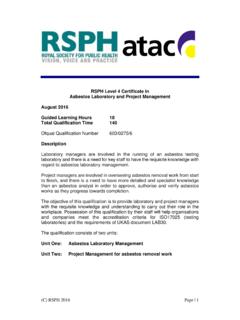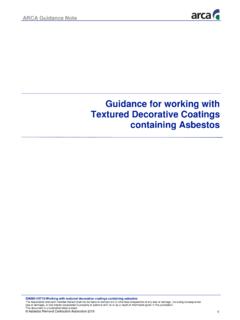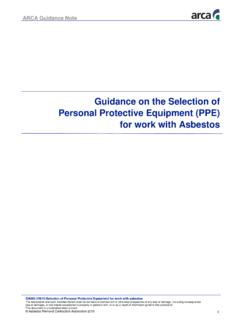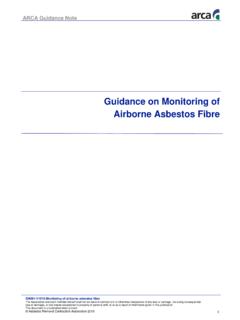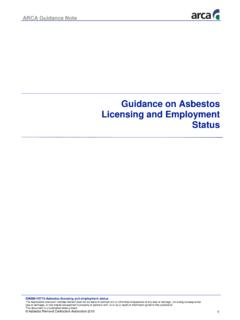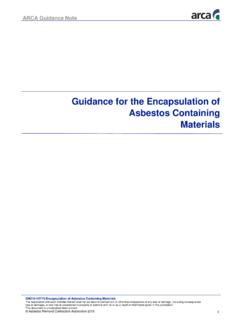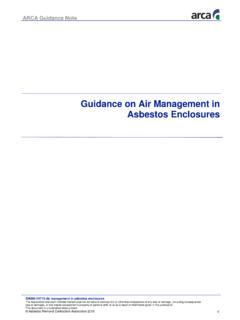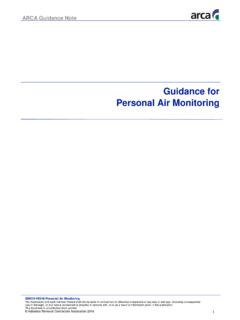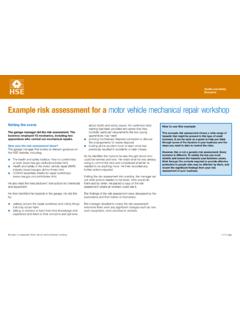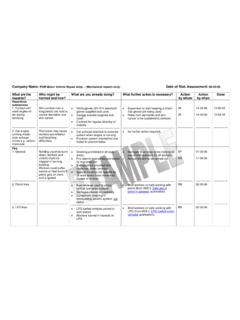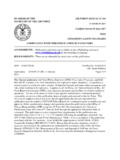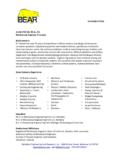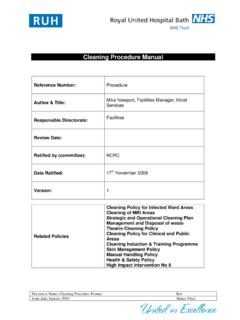Transcription of Guidance on Electrical Isolations and Asbestos Work
1 1 GN007-V0715- Electrical Isolations and Asbestos work The Association and each member thereof shall not be liable in contract tort or otherwise irrespective of any loss or damage, (including consequential loss or damage), or any nature occasioned to property or persons with, to or as a result of information given in this publication. This document is uncontrolled when printed. Asbestos Removal Contractors Association 2015 ARCA Guidance Note Guidance on Electrical Isolations and Asbestos work 2 GN007-V0715- Electrical Isolations and Asbestos work The Association and each member thereof shall not be liable in contract tort or otherwise irrespective of any loss or damage, (including consequential loss or damage), or any nature occasioned to property or persons with, to or as a result of information given in this publication.
2 This document is uncontrolled when printed. Asbestos Removal Contractors Association 2015 ARCA Guidance Note Guidance ON Electrical Isolations AND Asbestos work 1. BACKGROUND Electrical hazards can be a significant issue for Asbestos removal companies: poorly managed work on or near Electrical equipment can be fatal, but risk assessments and plans of work often fail to demonstrate a thorough site-specific assessment of risk, in order to identify appropriate control measures. The most straightforward AIB removal job will be complicated by the presence of light fixtures and fittings. Controlled Asbestos removal necessarily involves the application of water and surfactant increasing Electrical safety risks.
3 In addition, Asbestos removal contractors are often required to work in voids etc. where live conductors are likely to be found. This note presents a brief overview of requirements in such circumstances. Electrical risks can arise in many forms: poorly maintained / inappropriate Electrical equipment, buried cables, overhead lines etc. In all cases, your general assessment of the work you do should have identified standard procedures for carrying out work safely. Site specific assessments and methods will build on these general procedures and take into account significant risks present on any given particular site. 2. KEY POINTS When is isolation likely to be appropriate?
4 When removal work requires staff to work on or near live conductors. For example: removing Electrical equipment (lighting, machinery, fuse-boxes) using surfactant near light fittings or cable runs Equipment / conductors will be considered to be live unless they have been positively identified as dead. What does a good isolation look like? A locked-off switch (with warning sign attached); the unique key should be under the control of the people doing the work . Verbal confirmation of an isolation is not sufficient. Whose responsibility is it? The licensed contractor, as the employer, always has a basic duty to ensure safe systems of work etc. Isolations are likely to require cooperation and coordination with a number of parties: the licence holder, client, principal contractor etc.
5 3 GN007-V0715- Electrical Isolations and Asbestos work The Association and each member thereof shall not be liable in contract tort or otherwise irrespective of any loss or damage, (including consequential loss or damage), or any nature occasioned to property or persons with, to or as a result of information given in this publication. This document is uncontrolled when printed. Asbestos Removal Contractors Association 2015 ARCA Guidance Note 3. RISK ASSESSMENT, HEALTH AND SAFETY MANAGEMENT AND Electrical RISKS Health and Safety at work etc. Act 1974 and the Management of Health and Safety Regulations 1999 set out legal requirements for controlling significant risks arising from work activities.
6 Asbestos removal contractors often refer to the Control of Asbestos Regulations and associated Approved Code of Practice, but any significant risks whether Asbestos related or not, should be addressed in the site-specific plan of work for Asbestos removal. The Construction (Design and Management) Regulations place specific duties on contractors and clients, focusing on effective planning, coordination and competence. The Electricity at work Regulations 1989 require safe systems of work to be in place and also that employees have appropriate technical knowledge, tools, test equipment and personal protective equipment. With regard to the potential for working near live conductors, the regulations state that: No person shall be engaged in any work on / near live conductors unless It is unreasonable in all the circumstances for it to be dead, AND It is reasonable in all the circumstances for him to be at work on or near it while it is live; AND Suitable precautions are taken to prevent injury.
7 In practice, it is likely to be considered reasonable to make live conductors dead prior to standard Asbestos removal jobs; one of the purposes of the notification / planning requirements is to for allow all necessary preparation to be carried out. Multiple parties (clients, principal contractors, removal contractors etc.) may have a part to play in ensuring that a work site is safe and healthy. The key is co-ordination, effective communication and co-operation between all those involved. Contractors often rely on others to ensure that Electrical Isolations are in place. Where this is the case, there should be very clear confirmation of how this has been achieved.
8 The standards for Isolations are described below: verbal assurances that Isolations have been made are not sufficient and reasonable enquiries should be made to check the competency of those carrying out the Isolations . 4. GENERAL PROCEDURES Asbestos removal teams should not work in the vicinity of live conductors: accidental contact (or contact with surfactant) can be fatal and it is relatively simple to isolate circuits and check they are dead. Live working is generally only acceptable where, for example, trained electricians are fault-finding or testing and suitable precautions are in place to prevent injury. Adequate planning, Standard Procedures, basic awareness training and choice of equipment should ensure significant Electrical risks are controlled for Asbestos removal companies.
9 Managers should be able to: Liaise with clients regarding power requirements and limitations. 4 GN007-V0715- Electrical Isolations and Asbestos work The Association and each member thereof shall not be liable in contract tort or otherwise irrespective of any loss or damage, (including consequential loss or damage), or any nature occasioned to property or persons with, to or as a result of information given in this publication. This document is uncontrolled when printed. Asbestos Removal Contractors Association 2015 ARCA Guidance Note Carry out site specific assessments that include consideration of any live or suspect equipment and conductors. Where it is foreseeable that staff / suppression liquids could come into contact with live conductors, arrangements must be made for isolation and in most cases, this will be the significant finding of the assessment that will need to be recorded.
10 Produce a plan of work that is clear on how isolation is expected to be demonstrated. Successful isolation should be recorded as a hold point, or similar. Site teams should be able to: Look for (potential) conductors etc. as part of their routine on-site assessments before starting work Identify situations where work would be expected to STOP until suitable Isolations and assurances are provided. 5. METHODS OF isolation isolation means making a circuit dead and preventing it from becoming charged during the work . In other words, circuits must be locked off and controlled. Switching off, removing a fuse or covering a switch with masking tape etc. are easily bypassed.
